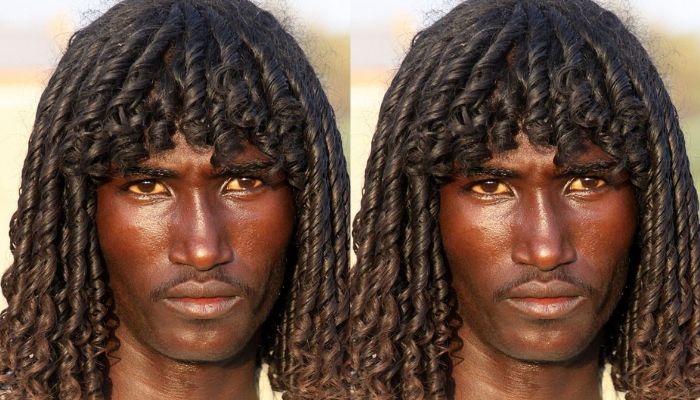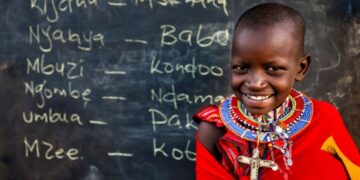Beauty they say is relative, what might be beautiful to some might not be to others. In this article, we will be looking at beauty practices across Africa. These beauty practices are passed down from generation to generation.
Subsequently, with the emergence of modern beauty practices, some of the ancient African beauty practices have been neglected. Nevertheless, some have found a way to incorporate these practices into modern-day beauty practices, while the ones that couldn’t, have been completely neglected.
African Beauty Practices
1. Asdago – Afar Tribe

The Afar people also known as Danakil, Adali, or Odali are indigenous to Northeast Africa specifically northeastern Ethiopia, Djibouti, and Eritrea. They are part of the Cushitic branch of the Afro-Asiatic family. The Afar people were said to have been in existence since the 13th century.
The men of the Afar tribe have a famous practice that involves the use of a rather unusual ingredient to create beautiful locks on their hair. The Asdago is a hairstyle created using cow fat and butter to form beautiful locks on the hair and subsequently, protect it from the sun and keep it perfectly supple. The style is created using a stick to create beautiful curls.
The Afar men are not the only people who use butter on their hair. The Karrayyu are an ancient nomadic group who live in the Awash Valley in the Fantalle district of Ethiopia. The people of the Karrayyu tribe also use butter on their hair.
In the modern day, the hairstyle of the Afar people is called “Finger Curls” and styling gel is used instead of cow butter.
2. The Red Ochre – Hamer Tribe
The Hamer people of the Omo Valley of Ethiopia are known to be one of the friendliest tribes in the country. They are also famous for the hairstyle which they achieve with the use of cow butter, risen, and red ochre.
The mixture is used to keep their locks in place, sometimes, they put so much of it that it runs down their back, making it look like blood.
Similarly, the Himba people of Namibia also use red ochre paste on their hair and their entire bodies.
3. Smoke Bath – Himba Tribe
One of the most fascinating beauty practices of the Himba women is the smoke bath. The women of the Himba Tribe are not allowed to bathe with water. This restriction came about as a result of the drought suffered in the area, which caused women to be banned from the use of water.
In order to preserve hygiene, the Himba women came up with the idea of smoke bathing. They would take and burn some herbs and cover themselves in the smoke with a blanket. This would cause perspiration which cleanses them and gives them very shiny and glowing skin.
4. Ear Stretching – Maasai Tribe
The Maasai tribe of Kenya practice a rare beauty tradition known as ear stretching. It is started by piercing the earlobes and subsequently, using larger pieces of stone, wood, tusk, or thorns to stretch the pierce earlobes.
Both men and women of the Maasai tribe practice ear stretching. The older a person is the wider and more stretched his earlobes would be. It is often associated with wisdom and bravery.
Other tribes that had the practice includes ancient Egyptians, Mursi tribe of Ethiopia, and the Fulani tribe of West Africa.
5. Kapapo – Mucawana Tribe
The Mucawana tribe is predominantly found in Angola, they are also found in some parts of Namibia. They are an indegineous tribe of nomadic people who still live and dress like their fore-fathers. These set of people have refused to accept civilization and chose to live the traditional way their ancestors lived.
Their women have a rather bizarre hairstyles called the Kapapo. It is made from cow dung, animal fat, and herbs to make the mixture fragrant. They also use the mixture to make accessories like bangles and anklets.
6. Nantombi – Mwila Tribe
The Mwila or Mumuhuila people of Angola are a semi-nomadic ethnic group of Bantu origins. History states that the migrated to Angola during the Great Bantu Migration.
The women of the tribe have a very unique way of styling their hair. They carry their hair in large locks called the “Nantombi”. The nantombi is made from a powder called oncula which is gotten from crushed red stone. Dried cow dung, herbs, crushed tree barks, and a mixture is added to form a paste which is used to create the magnificent locks and then adorned with beads and cowries.
The number of nantombis on a woman’s head has a lot of significance and tells a story about her. Young women and girls of the Mwila tribe often carry 4 to 6 nantombis. Therefore, if a woman has 3 nantombis, it means she has lost a family member.
7. Niksat – Ethiopia
In Ethiopia, there is a common practice known as the Niksat. It is an age-old practice of body art practiced by the women and girls of the area. It was done by tattoo professionals known as the Nekash. They give their clients a local liquor known as Areki, which serves as anesthesia before the procedure is done.
The Nekash does the tattoo by rubbing soot or charcoal powder and piercing the skin with fine needles until the color is imprinted in the skin. It might take doing it for 2-3 days consecutively before getting the desired result. After it is done, the young girls do not go out for up to 2 weeks in order to allow it heal.
Once properly done, it doesn’t fade easily and can last till old age. The traditional patterns done usually had meanings, however, as civilization swept through the country, these traditional patterns were replaced with foreign patterns. Ancient Egyptians also tattooed their bodies during the 12th and 15th centuries.
8. Tchoodi – Fulani Tribe
The fulani tribe is the largest nomadic group in the world. They spread over many countries. The Fulani tribe is predominantly found in West, Central, and Northern Africa. They are one of the most widely dispersed and culturally diverse people in Africa.
Once upon a time, the Fulani women use a black lip tattoo to symbolize of beauty and courage. This practice was mainly done in by the Fulani people of Mali. It is done as a rite of passage from childhood to adulthood and aimed at making the woman look more beautiful and attractive.
This traditional tattoo is done using a fine hot needle and a natural ink. After the procedure, the woman is fed only liquid through a straws for up to three weeks until it is completely healed. It is first done to the lower part of the mouth but after the woman is married, it is done to the upper part to show that she is taken.
See Also: 10 Shocking Truths About Slave Trade History In Africa
9. Lip Plates – Mursi Tribe
The Mursi tribe of Omo valley, Ethiopia are famous for their wooden lip plates. These lip plates are a symbol of beauty among the Mursi women.
The lip of the Mursi girl’s lip is cut at the age of 15 or 16 and held open by a sodden plug until it heals. After it is healed, the lip stretching process begins. The lip plates are increased as time goes on.
Apart from being a symbol of beauty, these lip plates also signifies a woman’s commitment to her husband. It is removed after the death of her husband since it is said that her external beauty fades after he is no more, causing her to become unattractive.
10. Face Painting – Wodaabe Tribe
Makeup and pageants are done majorly among women but here’s a plot twist. The men of the Wodaabe tribe of Niger participate in a beauty pageant during the annual Gerewol festival.
They paint their faces with red, white, and yellow clay. Additionally, they apply lipsticks and beads to make them look spectacular. They are referred to as “The vainest people in the world”. The Wodaabe men believe they are the most handsome set of men in the world and to ensure that they are always spectacular, they move around with mirrors.




















